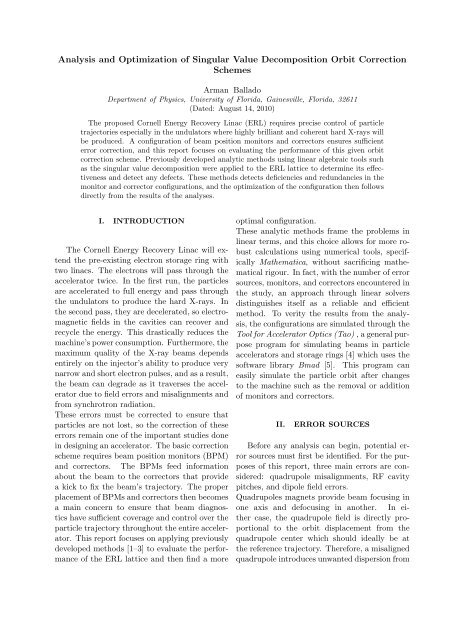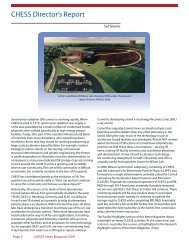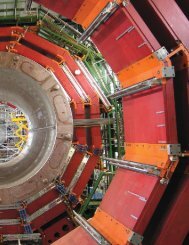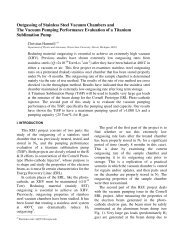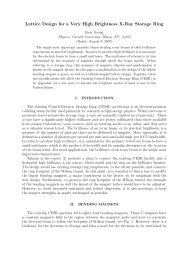Analysis and Optimization of Singular Value Decomposition Orbit ...
Analysis and Optimization of Singular Value Decomposition Orbit ...
Analysis and Optimization of Singular Value Decomposition Orbit ...
Create successful ePaper yourself
Turn your PDF publications into a flip-book with our unique Google optimized e-Paper software.
<strong>Analysis</strong> <strong>and</strong> <strong>Optimization</strong> <strong>of</strong> <strong>Singular</strong> <strong>Value</strong> <strong>Decomposition</strong> <strong>Orbit</strong> Correction<br />
Schemes<br />
Arman Ballado<br />
Department <strong>of</strong> Physics, University <strong>of</strong> Florida, Gainesville, Florida, 32611<br />
(Dated: August 14, 2010)<br />
The proposed Cornell Energy Recovery Linac (ERL) requires precise control <strong>of</strong> particle<br />
trajectories especially in the undulators where highly brilliant <strong>and</strong> coherent hard X-rays will<br />
be produced. A configuration <strong>of</strong> beam position monitors <strong>and</strong> correctors ensures sufficient<br />
error correction, <strong>and</strong> this report focuses on evaluating the performance <strong>of</strong> this given orbit<br />
correction scheme. Previously developed analytic methods using linear algebraic tools such<br />
as the singular value decomposition were applied to the ERL lattice to determine its effectiveness<br />
<strong>and</strong> detect any defects. These methods detects deficiencies <strong>and</strong> redundancies in the<br />
monitor <strong>and</strong> corrector configurations, <strong>and</strong> the optimization <strong>of</strong> the configuration then follows<br />
directly from the results <strong>of</strong> the analyses.<br />
I. INTRODUCTION<br />
The Cornell Energy Recovery Linac will extend<br />
the pre-existing electron storage ring with<br />
two linacs. The electrons will pass through the<br />
accelerator twice. In the first run, the particles<br />
are accelerated to full energy <strong>and</strong> pass through<br />
the undulators to produce the hard X-rays. In<br />
the second pass, they are decelerated, so electromagnetic<br />
fields in the cavities can recover <strong>and</strong><br />
recycle the energy. This drastically reduces the<br />
machine’s power consumption. Furthermore, the<br />
maximum quality <strong>of</strong> the X-ray beams depends<br />
entirely on the injector’s ability to produce very<br />
narrow <strong>and</strong> short electron pulses, <strong>and</strong> as a result,<br />
the beam can degrade as it traverses the accelerator<br />
due to field errors <strong>and</strong> misalignments <strong>and</strong><br />
from synchrotron radiation.<br />
These errors must be corrected to ensure that<br />
particles are not lost, so the correction <strong>of</strong> these<br />
errors remain one <strong>of</strong> the important studies done<br />
in designing an accelerator. The basic correction<br />
scheme requires beam position monitors (BPM)<br />
<strong>and</strong> correctors. The BPMs feed information<br />
about the beam to the correctors that provide<br />
a kick to fix the beam’s trajectory. The proper<br />
placement <strong>of</strong> BPMs <strong>and</strong> correctors then becomes<br />
a main concern to ensure that beam diagnostics<br />
have sufficient coverage <strong>and</strong> control over the<br />
particle trajectory throughout the entire accelerator.<br />
This report focuses on applying previously<br />
developed methods [1–3] to evaluate the performance<br />
<strong>of</strong> the ERL lattice <strong>and</strong> then find a more<br />
optimal configuration.<br />
These analytic methods frame the problems in<br />
linear terms, <strong>and</strong> this choice allows for more robust<br />
calculations using numerical tools, specifically<br />
Mathematica, without sacrificing mathematical<br />
rigour. In fact, with the number <strong>of</strong> error<br />
sources, monitors, <strong>and</strong> correctors encountered in<br />
the study, an approach through linear solvers<br />
distinguishes itself as a reliable <strong>and</strong> efficient<br />
method. To verity the results from the analysis,<br />
the configurations are simulated through the<br />
Tool for Accelerator Optics (Tao) , a general purpose<br />
program for simulating beams in particle<br />
accelerators <strong>and</strong> storage rings [4] which uses the<br />
s<strong>of</strong>tware library Bmad [5]. This program can<br />
easily simulate the particle orbit after changes<br />
to the machine such as the removal or addition<br />
<strong>of</strong> monitors <strong>and</strong> correctors.<br />
II.<br />
ERROR SOURCES<br />
Before any analysis can begin, potential error<br />
sources must first be identified. For the purposes<br />
<strong>of</strong> this report, three main errors are considered:<br />
quadrupole misalignments, RF cavity<br />
pitches, <strong>and</strong> dipole field errors.<br />
Quadrupoles magnets provide beam focusing in<br />
one axis <strong>and</strong> defocusing in another. In either<br />
case, the quadrupole field is directly proportional<br />
to the orbit displacement from the<br />
quadrupole center which should ideally be at<br />
the reference trajectory. Therefore, a misaligned<br />
quadrupole introduces unwanted dispersion from
2<br />
FIG. 1: Quadrupole Misalignment<br />
III.<br />
GENERALIZED RESPONSE<br />
MATRICES<br />
FIG. 2: RF cavity pitch<br />
an effective dipole field. For a quadrupole magnet<br />
with a center shifted from the origin to<br />
(δx, δy), it effectively steers a particle beam by<br />
∆θ x = k l δx (1)<br />
∆θ y = −k l δy (2)<br />
where k l is the integrated quadrupole strength<br />
[6].<br />
An RF cavity accelerates a particle beam longitudinally,<br />
but if it has a pitch angle, it introduces<br />
a transverse acceleration leading to deflections<br />
<strong>and</strong> emittance growth. A cavity with a pitch<br />
angle ϕ generates an effective steering<br />
∆θ ≈ ∆P<br />
P<br />
ϕ, (3)<br />
where P is the final on-axis momentum <strong>and</strong> ∆P<br />
is the momentum gain [6].<br />
The dipole fields bend the beam around the designed<br />
trajectory, but errors in this field can easily<br />
result in a different bending radius, deflecting<br />
the beam away from the reference orbit.<br />
After the identification <strong>of</strong> these error sources,<br />
the right coefficients map them to the appropriate<br />
spaces such as the orbit monitor space,<br />
<strong>and</strong> the mapping is done through generalized response<br />
matrices. Response matrices relate a specific<br />
action imparted by an actuator A with its<br />
result to a responder R defined by the equation<br />
R = M RA A, where M RA is the response coeffecient<br />
[3]. This relation may be further exp<strong>and</strong>ed<br />
to include m responders <strong>and</strong> n actuators represented<br />
by column vectors.<br />
There are several generalized response matrices<br />
crucial for the analyses. The error-to-monitor<br />
response matrix M EM relates all potential error<br />
sources to the orbit disturbance at the monitors.<br />
A similar matrix, M EA , summarizes the<br />
orbit errors at all representative elements. These<br />
matrices must include all major potential error<br />
sources that the system is designed to correct.<br />
Another pair <strong>of</strong> response matrices are the<br />
corrector-to-monitor M CM <strong>and</strong> corrector-to-alllocation<br />
M CA matrices. These describe the orbit<br />
disturbances caused by the angle kicks from<br />
the correctors. For the purpose <strong>of</strong> corrector optimization,<br />
it helps to construct two other response<br />
matrices. The first is the response matrix<br />
M AM which represents the orbit error at<br />
the monitors due to angle kicks at all representative<br />
elements (i.e. magnetic elements, mainly<br />
the quadrupoles). It provides a list <strong>of</strong> potential<br />
new correctors <strong>and</strong> its contribution to orbits at<br />
the monitors. Finally, the matrix M AA takes<br />
the same actuators but propagates its effects to<br />
all locations. These response matrices with their<br />
respective actuators <strong>and</strong> responders are summarized<br />
in Table I.<br />
To generate these response matrices, Tao has<br />
a comm<strong>and</strong> that immediately calculates the<br />
derivative dModel V alue/dV ariable [4] which<br />
determines how a change in a variable affect a<br />
data. Each derivative becomes the coefficient<br />
M ij between the i-th responder <strong>and</strong> the j-th<br />
actuator. One only needs to use the appropriate<br />
data (responders) <strong>and</strong> variable (actuators) in<br />
TAO <strong>and</strong> construct the matrix from the derivative.<br />
For example, M CM is formed from the
3<br />
TABLE I: Summary <strong>of</strong> Generalized Response Matrices<br />
Matrix Actuator<br />
Responder<br />
M CM Corrector Kicks <strong>Orbit</strong> at monitors<br />
M CA Corrector Kicks <strong>Orbit</strong> at all elements<br />
M EM Potential Error Sources <strong>Orbit</strong> at monitors<br />
M EA Potential Error Sources <strong>Orbit</strong> at all elements<br />
M AM Quadrupole Kicks <strong>Orbit</strong> at monitors<br />
M AA Quadrupole Kicks <strong>Orbit</strong> at all elements<br />
calculation <strong>of</strong> the derivative matrix between the<br />
variable kicks at the correctors <strong>and</strong> the orbit at<br />
the beam position monitors.<br />
IV. SINGULAR VALUE<br />
DECOMPOSITION ORBIT CORRECTION<br />
A system <strong>of</strong> linear equation A · x = b can be<br />
solved exactly using the inverse A −1 <strong>of</strong> the coefficient<br />
matrix, so that x = A −1 · b However this<br />
presents an obvious problem for singular matrices<br />
whose inverses do not exist. For example,<br />
the matrix<br />
( ) 1 0<br />
A =<br />
(4)<br />
1 0<br />
does not have an inverse. In such cases, an exact<br />
solution to the system also does not exist, but it<br />
may suffice to have a linear least square solution.<br />
These solutions are calculated in different ways,<br />
one being the singular value decomposition. <strong>Singular</strong><br />
value decomposition, or SVD, decomposes<br />
an M × N matrix A into a product <strong>of</strong> three<br />
matrices U, W, <strong>and</strong> V:<br />
A = U · W · V T , (5)<br />
where U <strong>and</strong> V are M × M <strong>and</strong> N × N columnorthonormal<br />
matrices, respectively. The M × N<br />
matrix W is a diagonal matrix with positive or<br />
zero elements called the singular values. The<br />
previous example is decomposed as<br />
( ) 1 0<br />
= 1 ( ) ( √ ) ( )<br />
1 −1 2 0 1 0<br />
√ · · .<br />
1 0 2 1 1 0 0 0 1<br />
(6)<br />
One <strong>of</strong> the SVD’s usefulness comes from its<br />
construction <strong>of</strong> the orthonormal bases for the<br />
nullspace <strong>and</strong> range <strong>of</strong> a matrix. The columns <strong>of</strong><br />
V that correspond to very small or zero singular<br />
values in W form the orthonormal set <strong>of</strong> basis<br />
vectors for the nullspace while those <strong>of</strong> U that<br />
have non-zero singular values are the orthonormal<br />
basis for the range [7]. A closer inspection<br />
<strong>of</strong> the decomposition <strong>of</strong> the example above easily<br />
reveals this property. The optimization methods<br />
discussed later will exploit this property <strong>of</strong> the<br />
SVD.<br />
The pseudoinverse <strong>of</strong> A is the defined as :<br />
A † = V·[diag(1/w j )] · U T (7)<br />
replacing 1/w j by zero if w j = 0. For a set <strong>of</strong><br />
simultaneous linear equations A · x = b, the solution<br />
x = A † · b does not exactly solve the original<br />
set <strong>of</strong> equation but will do so in the leastsquares<br />
sense. It finds the x which minimizes<br />
the residual r ≡ |A · x − b|.<br />
In terms <strong>of</strong> orbit correction, the linear equation<br />
<strong>of</strong> the orbit is<br />
R = M EM · A E + M CM · A C , (8)<br />
<strong>and</strong> the goal is to find the corrector kicks<br />
A C that minimizes the residual orbit after<br />
correction. From SVD, the best corrector<br />
kicks A C best<br />
that minimizes the residue |R| is<br />
A C best = M† CM · MEM · A E .<br />
Our Tao simulation also uses SVD to correct the<br />
orbit. It internally generates the response matrices<br />
<strong>and</strong> applies the SVD on the BPM readings.<br />
The corrector kicks are modified <strong>and</strong> the step is<br />
repeated until enough particles pass through the<br />
entire lattice without being lost to the chamber<br />
walls.<br />
V. PERFORMANCE ANALYSIS<br />
A. Secondary Response Matrices<br />
The following secondary response matrices<br />
are derived by linear algebraic operations on the<br />
general response matrices. They help further<br />
quantify the performances <strong>of</strong> the configuration
4<br />
allowing a more intuitive comparison <strong>of</strong> the performance<br />
before <strong>and</strong> after optimization. These<br />
matrices are originally from [3].<br />
• Unobservable Error<br />
M unobs = M EA · (I − M † EM · MEM ) (9)<br />
This matrix maps from the error space to<br />
its null space then to all monitor space<br />
(i.e. For a given error configuration, it<br />
finds the part <strong>of</strong> this configuration that is<br />
undetectable at the monitors then propagates<br />
it at all the elements).<br />
• Corrector Range<br />
M resp<br />
CME = M† CM · MEM (10)<br />
Given an error configuration, the matrix<br />
maps it to the corrector space after an<br />
SVD type correction, providing the necessary<br />
kicks to minimize the orbits at the<br />
correctors. It was already encountered in<br />
the section about SVD in the equation<br />
A C best = M† CM · MEM · A E .<br />
• Residual <strong>Orbit</strong><br />
M resid<br />
CMA = M EA − M CA · M resp<br />
CME<br />
(11)<br />
With a given corrector configuration, this<br />
response matrix maps from the errors to<br />
the orbit after steering.<br />
B. Mapping Errors<br />
All <strong>of</strong> these response matrices map the error<br />
space to the relevant responder space, thus providing,<br />
for instance, the corrected orbit at all<br />
the elements given a specific error combination.<br />
This mapping is a straightforward multiplication<br />
but it also presents an obvious limitation<br />
because errors are hidden from direct measurement<br />
in beam diagnostics. Instead, errors are<br />
estimated through probability distributions, so<br />
these error distributions must be mapped to the<br />
appropriate distributions in the responder space.<br />
Recalling that for r<strong>and</strong>om variables R i <strong>and</strong> A j<br />
related by a constant coefficient<br />
n∑<br />
R i = M ij A j , (12)<br />
j=1<br />
their variances are<br />
V ar(R i ) =<br />
n∑<br />
MijV 2 ar(A j )<br />
j=1<br />
+ 2 ∑ j
5<br />
keep proper dimensions for matrix multiplication.<br />
The scaled matrices become<br />
VI.<br />
( M<br />
M CM CM<br />
=<br />
W<br />
( M<br />
M EM EM<br />
=<br />
Z<br />
)<br />
, (16)<br />
W ii = √ w i (17)<br />
)<br />
, (18)<br />
Z ij = 0, i = 1, 2, · · · , N C ; (19)<br />
j = 1, 2, · · · , N E (20)<br />
LATTICE OPTIMIZATION<br />
PROCEDURE<br />
The following section describes the optimization<br />
algorithms developed in [1, 2]. They rely on<br />
the general response matrices M EM , M CM <strong>and</strong><br />
M AM <strong>and</strong> their corresponding all-element counterparts<br />
to determine the c<strong>and</strong>idate monitors<br />
<strong>and</strong> correctors for addition <strong>and</strong> removal. To add<br />
monitors, one simply appends the desired monitor<br />
represented by a row from the all-element<br />
matrix to the original matrix, <strong>and</strong> new correctors<br />
are added by including columns from M AM .<br />
Monitors (correctors) are deleted by eliminating<br />
the respective rows (columns). The algorithms<br />
are summarized in Tables II,III,IV,<strong>and</strong> V.<br />
Each vector is then propagated to all elements<br />
using M EA . The largest orbit error lying outside<br />
a numerical criterion is noted, <strong>and</strong> a monitor is<br />
placed at its location. Similarly, very small singular<br />
values <strong>of</strong> M EM correspond to error combinations<br />
that are unobservable at the monitors.<br />
As discussed earlier, the columns <strong>of</strong> V in the<br />
decomposition that correspond to very small or<br />
zero singular values form an orthonormal basis<br />
for the null space, so these basis vectors result in<br />
unobservable orbits at the monitors. These errors<br />
are again propagated to all elements to find<br />
locations <strong>of</strong> the new monitors.<br />
Figure 3 illustrates an example <strong>of</strong> a large undetectable<br />
orbit. The black dots represent the<br />
monitors. Note that the orbit is well-behaved at<br />
these locations but have large errors once propagated<br />
at all the elements. In this example, a<br />
monitor should be placed at the orbit bump near<br />
the 300m mark.<br />
Unobserved <strong>Orbit</strong> m<br />
0.05<br />
0.00<br />
0.05<br />
0.10<br />
FIG. 3: Large Unobservable <strong>Orbit</strong><br />
A. Monitor Deficiency<br />
The only information about the orbit is gathered<br />
from the readings <strong>of</strong> the beam position monitors,<br />
so most <strong>of</strong> the orbit’s behavior in between<br />
monitors remains largely hidden from direct observation.<br />
As a result, large undetectable orbits<br />
may be present although the readings are well<br />
behaved.Then, monitors should be added at locations<br />
where this large orbits occur to eliminate<br />
the monitor deficiency.<br />
The unobservability <strong>of</strong> a configuration may be<br />
studied through the null space <strong>and</strong> small singular<br />
values <strong>of</strong> M EM . The null space <strong>of</strong> M EM<br />
forms an orthonormal basis <strong>of</strong> all A E that satisfy<br />
M EM · A E = 0. (21)<br />
0 100 200 300 400<br />
s m<br />
B. Monitor Redundancy<br />
The previous procedure can possibly add too<br />
many monitors that have a minimal contribution<br />
to improving observability, <strong>and</strong> excessive monitoring<br />
may even constrain the correctors [1]. The<br />
following algorithm detects <strong>and</strong> eliminates these<br />
redundancies. There are two parts in the program<br />
to minimize the monitor redundancy. The<br />
first looks at the coupling between the monitors<br />
<strong>and</strong> errors through the projection operator<br />
<strong>of</strong> M EM . This operator Π EM = M EM · M EM<br />
†
6<br />
TABLE II: Eliminating Monitor Deficiencies<br />
1 : Find the null space vectors E <strong>of</strong> M EM .<br />
2 : Calculate V A = M EA · E, for every E.<br />
3 : For each V A add a monitor at the index <strong>of</strong> its largest element greater than R.<br />
4 : Repeat steps 1-3 until all elements <strong>of</strong> V A are less than R.<br />
5 : Decompose M EM by SVD.<br />
6 : Take the column vector v <strong>of</strong> V that corresponds to the smallest singular value.<br />
7 : Calculate V A = M EA · v.<br />
8 : Repeat steps 3,5-7 until all elements <strong>of</strong> V A are less than R.<br />
divides the orbit vectors into parts that are<br />
spanned by the errors, <strong>and</strong> it is applied to unit<br />
orbit peaks X i at each monitor. The vector X i<br />
contains zeros except for the i-th row representing<br />
a single reading at i-th monitor. For each<br />
monitor, the fractional part | ¯X i |/|X i | is calculated,<br />
where ¯X i = X i − Π EM · X i . This fraction<br />
reflects the amount <strong>of</strong> the unit orbit peak that<br />
is not caused by the errors, <strong>and</strong> the i-th monitor<br />
is removed if its fractional component exceeds a<br />
numerical criteria (1 − R). Thus,error-induced<br />
orbits must contribute to at least a fraction R <strong>of</strong><br />
a monitor reading if this monitor is to be kept.<br />
The second part <strong>of</strong> this optimization algorithm<br />
compares the Gram determinant <strong>of</strong> M EM <strong>and</strong><br />
the orthogonality <strong>of</strong> the monitors. For the smallest<br />
singular value <strong>of</strong> M EM , the index <strong>of</strong> the<br />
largest component <strong>of</strong> the corresponding column<br />
vector <strong>of</strong> U represents a redundant monitor that<br />
should be removed. This program is iterated until<br />
the Gram determinant exceeds S N M<br />
.<br />
The Gram determinant measures the orthogonality<br />
<strong>of</strong> the row vectors <strong>of</strong> a matrix. If the Gram<br />
determinant is non-zero then the vectors are linearly<br />
independent, <strong>and</strong> hence orthogonal. By<br />
deleting rows <strong>of</strong> the matrix, the row vectors become<br />
more independent. The criterion S is the<br />
required Gram determinant between two monitors,<br />
<strong>and</strong> by calculating S N M<br />
, one finds the required<br />
orthogonality measure for all the remaining<br />
monitors.<br />
The Gram determinant G M <strong>of</strong> the matrix M is<br />
G M = ( ∏ j<br />
S M j ) 2 (22)<br />
where Sj<br />
M is the j-th singular value. The Gram<br />
determinant can be normalized as follows<br />
¯ G M = G M /L M (23)<br />
L M = ∏ j<br />
L M = ∏ i<br />
( ∑ i<br />
( ∑ j<br />
M ij 2 ), rows > columns (24)<br />
M ij 2 ), columns > rows (25)<br />
To illustrate, consider a basic configuration with<br />
three error sources <strong>and</strong> monitors. The configuration<br />
has the following simple response matrix<br />
<strong>and</strong> singular value decomposition:<br />
⎛<br />
⎞<br />
0.99 1.99 2.99<br />
M EM = ⎝ 2.00 3.00 4.00 ⎠ (26)<br />
1.01 2.01 3.01<br />
⎛<br />
−0.493381 −0.516403 −0.699931<br />
U = ⎝ −0.713325 0.700691 −0.01414<br />
−0.497737 −0.492302 0.714071<br />
⎛<br />
W = ⎝<br />
⎛<br />
⎞<br />
⎠<br />
(27)<br />
⎞<br />
7.53586 0. 0.<br />
0. 0.459751 0. ⎠ (28)<br />
0. 0. 3.63 · 10 −17<br />
−0.320841 0.854631 0.408248<br />
V = ⎝ −0.547018 0.184673 −0.816497<br />
−0.773196 −0.485285 0.408248<br />
(29)<br />
The configuration clearly has a redundancy<br />
in the first <strong>and</strong> last monitors. The smallest singular<br />
value <strong>of</strong> 0. corresponds to the third column<br />
<strong>of</strong> U, <strong>and</strong> the largest element <strong>of</strong> this column<br />
⎞<br />
⎠
7<br />
vector indicates that the last monitor should be<br />
removed. The first part <strong>of</strong> the algorithm also<br />
points to this same redundancy. Recalling that<br />
¯X i = X i − Π EM · X i ,<br />
⎛<br />
X 1 = ⎝<br />
⎛<br />
X 2 = ⎝<br />
⎛<br />
X 3 = ⎝<br />
⎞ ⎛<br />
1<br />
0 ⎠ , ¯X 1 = ⎝<br />
0<br />
⎞<br />
0.489903<br />
0.00989703 ⎠ , (30)<br />
−0.4998<br />
| ¯X 1 |<br />
= 0.699931 (31)<br />
|X 1 |<br />
⎛<br />
⎞<br />
0<br />
1 ⎠ , ¯X 2 =<br />
0<br />
⎝<br />
⎞<br />
0.00989703<br />
0.00019994 ⎠ , (32)<br />
−0.010097<br />
| ¯X 2 |<br />
= 0.01414 (33)<br />
|X 2 |<br />
⎛<br />
⎞<br />
0<br />
0 ⎠ , ¯X 3 =<br />
1<br />
⎝<br />
⎞<br />
−0.4998<br />
−0.010097 ⎠ , (34)<br />
0.509897<br />
| ¯X 3 |<br />
= 0.714071 (35)<br />
|X 3 |<br />
C. Corrector Deficiency<br />
Take the fraction <strong>of</strong> the error-induced orbit<br />
that is uncorrectable by the correctors. This<br />
fraction is calculated by applying the projection<br />
operator Π CM = M CM · M † CM on certain<br />
column vectors u i <strong>of</strong> U from the SVD <strong>of</strong> the<br />
M EM . Only column vectors with non-zero singular<br />
values or above the cut<strong>of</strong>f defined before<br />
are taken to ensure that only the basis for the<br />
range is considered for the optimization program.<br />
The projection finds the part u i that is<br />
uncorrectable, represented by Q u i<br />
M CM = |ū i |/|u i |,<br />
where ū i = u i − Π CM · u i . For the largest Q u i<br />
M CM<br />
greater than the criterion R, the inner product <strong>of</strong><br />
the corresponding ū i with all the column vectors<br />
<strong>of</strong> M AM is calculated to determine the location<br />
<strong>of</strong> the new corrector that best compensates for<br />
this deficiency. By taking this inner product,<br />
one essentially quantifies the amount by which<br />
the uncorrectable orbit represented by ū i is projected<br />
to the column vectors <strong>of</strong> M AM , so the<br />
procedure detects the location where a corrector<br />
would have the best contribution to this uncorrectable<br />
orbit.<br />
The required corrector kicking strengths also<br />
provides a pathway for eliminating corrector deficiencies.<br />
The pseudoinverse M † CM transforms<br />
from the orbit monitor space to the corrector<br />
space, so once applied to the u i defined above,<br />
the matrix finds the necessary corrector kicks<br />
K i = M † CM · u i. The largest kick Ki<br />
max for all<br />
K i greater than the corrector limit S indicates<br />
that the i-th corrector requires extremely strong<br />
kicks. Again, the inner product <strong>of</strong> its corresponding<br />
u i with all the column vectors <strong>of</strong> M AM<br />
is calculated where the largest inner product locates<br />
the best new corrector that can decrease<br />
the required kick from the i-th corrector.<br />
D. Corrector Redundancy<br />
The response matrix M CM is singular value<br />
decomposed to to find its singular values to find<br />
the column vector <strong>of</strong> V with the smallest singular<br />
values. This column vector represents the<br />
corrector combination that has minimal to no<br />
effect on the monitor orbit. The index j <strong>of</strong> its<br />
largest element is the j-th monitor that should<br />
be removed. The procedure is iterated until two<br />
numerical criteria are achieved.<br />
The first criterion is the matrix condition number<br />
defined as the ratio <strong>of</strong> the largest singular<br />
value to the smallest. This number measures the<br />
behavior <strong>of</strong> the response matrix; a matrix that<br />
has an infinite or extremely large condition number<br />
is singular or ill-conditioned while one with<br />
a smaller condition number is well-behaved. It is<br />
important to consider this behavior because an<br />
ill-conditioned matrix means that a small change<br />
in the input results in a large changes in the<br />
output, leading to unreliable solutions. While a<br />
definitive cut<strong>of</strong>f between an ill-conditioned <strong>and</strong><br />
well-behaved matrix does not exist, it is possible<br />
to pick out a sensible cut<strong>of</strong>f based on the problem’s<br />
requirements.<br />
The final criterion is S the measure <strong>of</strong> the orthogonality<br />
<strong>of</strong> the corrector effects on the monitors.<br />
The normalized Gram determinant <strong>of</strong><br />
M CM is compared with S N C<br />
, where N C is the<br />
number <strong>of</strong> remaining correctors. The significance<br />
<strong>of</strong> this criteria has already been discussed<br />
in the monitor redundancy section.
8<br />
TABLE III: Reducing Monitor Redundancies<br />
1 : For every unit orbit peak X i , calculate Q Xi<br />
= |Xi−MEM·M † EM·X i|<br />
M EM |X i|<br />
.<br />
2 : Delete the i-th monitor with Q Xi<br />
> (1 − R).<br />
M EM<br />
3 : Decompose M EM by SVD.<br />
4 : Take the column vector u <strong>of</strong> U with the smallest singular value.<br />
5 : Eliminate the i-th monitor corresponding<br />
to the index <strong>of</strong> the largest element <strong>of</strong> u.<br />
6 : Repeat steps 3-5 until Ḡ M EM > S N M<br />
.<br />
7 : Stop at any point when a minimally required number <strong>of</strong> monitors is achieved.<br />
TABLE IV: Eliminating Corrector Deficiencies<br />
1 : Take column vectors u i <strong>of</strong> U with non-zero singular values from the SVD <strong>of</strong> M EM .<br />
2 : For each u i , calculate Q ui<br />
= |ūi|<br />
M CM |u , where ū i| i = u i − M CM · M † CM · u i.<br />
3 : For Q ui<br />
> R, calculate the inner product <strong>of</strong> ū<br />
M CM i with all the column vectors <strong>of</strong> M AM .<br />
4 : Identify the index <strong>of</strong> the column <strong>of</strong> M AM with the largest inner product.<br />
5 : Add a corrector at this index.<br />
6 : Repeat steps 2 - 5 until all Q ui<br />
< R.<br />
M CM<br />
7 : Calculate K i = M † CM · u i for every u i .<br />
8 : Identify the largest element K max<br />
i for all K i .<br />
9 : Find the largest <strong>of</strong> all Ki max <strong>and</strong> take its corresponding u i .<br />
10 : Calculate the inner product <strong>of</strong> u i with all column vectors <strong>of</strong> M AM .<br />
11 : Identify the index <strong>of</strong> the column <strong>of</strong> M AM with the largest inner product.<br />
12 : Add a corrector at this index.<br />
13 : Repeat steps 7-12 until all Ki max < S.<br />
VII.<br />
APPLICATION TO THE SOUTH<br />
ARC SECTION OF THE ERL<br />
FIG. 4: SA: Residual <strong>Orbit</strong> before <strong>Optimization</strong><br />
To test these algorithms, they are first applied<br />
to the South Arc. The South Arc is a<br />
smaller section <strong>of</strong> the lattice that contains the<br />
majority <strong>of</strong> the undulators, thus it represents<br />
the primary needs <strong>of</strong> the machine. Since the<br />
ERL aims to generate X-ray beams, the orbit<br />
at the undulator remains a high priority that<br />
must be monitored to ensure that the optimization<br />
program does not compromise the orbit at<br />
these locations. The section also do not have the<br />
added complication <strong>of</strong> multipass elements, so the<br />
generalized response matrices are much easier to<br />
calculate.<br />
The current configuration <strong>of</strong> the South Arc contains<br />
103 BPMs <strong>and</strong> 62 correctors. Its baseline<br />
performance is in Figure 4. The residual orbit<br />
resulted from including quadrupole x-<strong>of</strong>fset er-<br />
Residual <strong>Orbit</strong> Sigma Μ m<br />
12<br />
10<br />
8<br />
6<br />
4<br />
2<br />
0<br />
0 100 200 300 400<br />
s m<br />
rors at all 111 quadrupole elements. These errors<br />
were given a st<strong>and</strong>ard deviation <strong>of</strong> 10µm. The<br />
results from the matrix calculations are depicted
9<br />
TABLE V: Minimizing Corrector Redundancies<br />
1 : Decompose M CM by SVD.<br />
2 : Obtain the column vector v <strong>of</strong> V with the smallest singular value.<br />
3 : Remove the corrector corresponding to the largest element <strong>of</strong> v.<br />
4 : Repeat steps 1-3 until the condition number N < S <strong>and</strong> ḠM CM > SN C<br />
.<br />
as solid lines. To verify their accuracy, they are<br />
compared with the results from the Tao simulation,<br />
depicted here as the black dots, <strong>and</strong> the<br />
two agree very well.<br />
The nine undulators are located where there are<br />
local minima around the 50, 80, 110, 135, 160,<br />
190, 315, 360, 400 meter marks. The orbits here<br />
should be kept at a minimum while optimizing<br />
<strong>and</strong> eliminating huge orbit peaks.<br />
A. <strong>Optimization</strong> <strong>of</strong> the Current<br />
Configuration<br />
The program simply rearranges the 103 monitors<br />
but reduces the number <strong>of</strong> correctors to 58. The<br />
figure represents the new residues as the red envelope.<br />
The residual orbits here are more evenly<br />
distributed <strong>and</strong> eliminated the major peaks from<br />
the original configuration, cutting the maximum<br />
peaks by more than a half, while having a minimal<br />
effect on the undulator orbits.<br />
FIG. 6: SA: Residual <strong>Orbit</strong> After Corrector <strong>Optimization</strong><br />
12<br />
12<br />
10<br />
FIG. 5: SA: Residual <strong>Orbit</strong> After <strong>Optimization</strong><br />
Residual <strong>Orbit</strong> Sigma Μ m<br />
10<br />
8<br />
6<br />
4<br />
Residual <strong>Orbit</strong> Sigma Μ m<br />
8<br />
6<br />
4<br />
2<br />
0<br />
0 100 200 300 400<br />
s m<br />
2<br />
0<br />
0 100 200 300 400<br />
s m<br />
The residual orbit after applying both the<br />
monitor <strong>and</strong> corrector optimization programs is<br />
shown in Figure 5. A new constraint was placed<br />
on the monitor redundancy algorithm due to its<br />
sensitivity. Monitors are placed before <strong>and</strong> after<br />
the undulators to increase the monitoring power<br />
at these elements, but the program deletes the<br />
first <strong>of</strong> these monitors. Therefore, an exception<br />
list <strong>and</strong> a new criterion indicating the minimum<br />
number <strong>of</strong> monitors required are introduced.<br />
Finally, the original correction scheme was optimized<br />
again using only the corrector program.<br />
This procedure assumes that the current lattice<br />
lack any significant monitor deficiencies <strong>and</strong> redundancies.<br />
It removed nine correctors while<br />
still improving the residual orbits, as depicted<br />
in Figure 6.<br />
VIII.<br />
CONCLUSION<br />
The program written in Mathematica takes as<br />
input the derivative data from Tao to construct<br />
the generalized response matrices. It separates<br />
the four optimization algorithms so they can be
10<br />
applied according to the needs <strong>and</strong> assumptions<br />
behind a given lattice though a full optimization<br />
involves the application <strong>of</strong> all four in the order<br />
that they are presented here.<br />
Its application to the South Arc <strong>of</strong> the ERL lattice<br />
has promising results indicating the effectiveness<br />
<strong>of</strong> these algorithms. The next step is to<br />
apply the study to the entire ERL lattice. The<br />
generality <strong>of</strong> the code facilitates this study since<br />
it only requires the data to generate the appropriate<br />
matrices then the optimization immediately<br />
follows.<br />
IX.<br />
ACKNOWLEDGMENTS<br />
Special thanks goes to my mentor, Chris<br />
Mayes, for his support <strong>and</strong> guidance throughout<br />
summer. I would also like to thank David<br />
Sagan for his help in solving technical problems<br />
with Tao. This project was support by the NSF<br />
Grant PHY-0849885 <strong>and</strong> DMR-0937466.<br />
[1] Y. Chao, <strong>Orbit</strong> Correction Methods - Basic Formulation,<br />
Current Application at Jefferson Lab,<br />
<strong>and</strong> Future Possibilities, Proc. Workshop on Automated<br />
Beam Steering <strong>and</strong> Shaping (ABS),<br />
Edited by Lindroos, CERN, (1998).<br />
[2] Y. Chao, Methods <strong>of</strong> <strong>Orbit</strong> Correction System<br />
<strong>Optimization</strong>, Proceedings <strong>of</strong> 1997 Particle Accelerator<br />
Conference, Vancouver, Canada.<br />
[3] Y. Chao & V. Mertens, <strong>Analysis</strong> <strong>and</strong> Optimisation<br />
<strong>of</strong> Oribt Correction Configurations Using<br />
Generalized Response Matrices <strong>and</strong> its Application<br />
to the LHC Injection Transfer Lines TI2 <strong>and</strong><br />
TI8, LHC Project Report 470, May 2001.<br />
[4] D. Sagan, J. Smith, The Tao Manual.<br />
[5] D. Sagan, Bmad: A relativistic charged particle<br />
simulation, Nuc. Instrum. Methods Phys. Res. A,<br />
558 (2006).<br />
[6] C. Song, G. H<strong>of</strong>fstaetter, Particle <strong>Orbit</strong> Correction<br />
in an Energy Recovery Linac, July 31, 2007.<br />
[7] W. Press, B. Flannery, S. Teukolsky, W. Vetterling,<br />
Numerical Recipies in C, Cambridge University<br />
Press, 1998.


